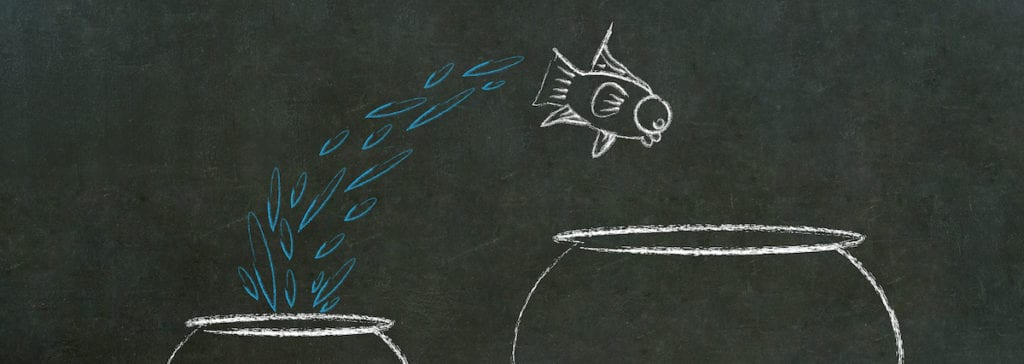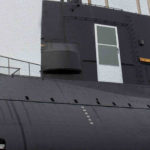
My wife and I recently spent some time in the town we lived in when we first got married. University students were moving back on campus (albeit to study virtually), the weather was just right, and the same songs were playing on the radio. I couldn’t help but think about what we would’ve been doing almost 20 years ago. Then I thought about the badass aquarium place we used to go to when we were bored. This place had the best saltwater tanks. Like one-hit-rapper-on-MTV-Cribs level. Then the idea struck.
One of the things you often hear in the aquarium community is that a fish only grows to the size of its tank. This doesn’t mean that Nemo becomes the size of a sturgeon in a house-sized aquarium. What it alludes to is that fish can reach their maximum size if they have adequate room to exercise, eat, the opposite of eat, and breathe properly. Bigger tanks provide that. The same can be said for people.
The growth mindset is everywhere. How many times throughout your career has your supervisor/boss/wrangler asked you to fill out your annual goals? Maybe they’ve made you watch a TED talk on unlocking your potential, or reminded you that you need to be constantly improving. I’m even guilty of constantly recommending books. Sound familiar?
While these practices are certainly helpful, sometimes they actually get in the way of more important tasks, the activities that contribute far more to sustaining the business. Single-mindedly chasing synthetic personal goals can force people to ignore obvious customer needs, or make them repeat themselves over and over, or even worse, force customers to wait for service while other tasks are taking place. While growth-oriented practices often work well for large corporations, small businesses don’t have the adequate personnel, or enough positions, to make use of these techniques. Yet other times, the opposite holds true.
Some employees are completely stunted by their organization. They blast past their goals every month. They peg every performance metric, then plateau. They’re tasked with coming up with new goals until they simply run out of compensation targets, customers, or ideas. They’re doing everything the books suggest. Their results are like clockwork. Simply put, the tank is too small.
Encouraging a growth mindset should always be executing well thought out processes. Taking a few quotes from a book, or benchmarking against the best and biggest, simply isn’t enough. Often times, the process creates more waste, discontent, and turnover than if not executed at all. Before jumping in head-first, it’s important to take two things into account:
The Size of the Fish
We’ve been practicing the “right-size” mentality at DealerKnows for a long time. By taking objective measurements of a given team, organization, and technology, we actively tailor tactics and strategy to maximize the sum capabilities of the organization. In layman’s terms, it means helping organizations become the best version of themselves they can be. One has to be extremely honest and realistic about the frontline workers, but moreover, the market, the leadership, the tools, and products or services available. The best people to put all the variables in motion just don’t grow on trees.
No matter how big you make the tank, some fish will always be small. The pool of talent is extremely limited, and it shrinks exponentially the further you move from the metros. It doesn’t mean that those in smaller communities can’t thrive and be successful. What it does mean is that they have a limited capacity to grow. No matter what the title, only so much leadership can be taught, and it certainly isn’t genetic. And, while some of the best sales people have a limited capacity to learn, it doesn’t limit their ability to be reliable employees who some customers absolutely love. Too many decision makers waste precious resources trying to mutate guppies into sharks. Embrace the qualities your fish have and give them the right-sized opportunity to succeed.
The Size of the Tank
More often than not, the very best run out of room to grow. Their environment simply isn’t big enough to reach their maximum potential. Now and again, they’re trapped with other bigger fish, starving for the same food, competing for the same space to grow. Adding more of anything just clogs up the system, forcing those in the tank to swim through even more of their own fetid waste. Extra-medium is the best they can hope for. Fancy lights and better decorations might make the tank look better. Without more room to flourish, and proper stewardship, there isn’t enough space to reach that maximum potential. There are only three options in this situation: Be satisfied, divide into multiple tanks, or be ready for some fish to grow legs.
Some fish never reach their full potential because they are simply in the wrong environment. At an absolute minimum, they are forced to stay in a position that doesn’t best suit their strengths. Instead of moving them to different surroundings, they’re forced to suffocate in place. No matter how much they get fed, there just isn’t enough room to grow. They can only reach the surface to discover that there’s no higher place to go.
The very best simply evolve beyond their constraints. Despite the limitations of their surroundings, they’re able to process all that they’ve been given, putting all the time and energy into new means to escape what’s limiting them. They no longer need what those above them can provide. As they push through their confines, they discover that there is so much more the world has to offer. While no longer swimming through the poison, they flourish in a completely new environment, free to grow in ways they didn’t think possible. Being force-fed in a tiny tank is already a distant memory.
Stewardship
The continuous improvement culture is something that needs to be taken very seriously. There’s absolutely nothing wrong with helping anyone become the best version of themselves. But, it’s fundamentally wrong to push people to become the best version of yourself. As leaders, it’s crucial to understand and embrace the limitations of your team. By forcing them into work, tasks, or goals that are outside their natural abilities you are setting them up for failure. In many instances, it expends time, money, and energy that can be put towards core activities. Many fish were forced to go belly-up chasing waterfalls, instead of sticking to the rivers and the lakes they were used to.
If the organization is intent on pushing personal growth for the sake of personal growth, then there absolutely must be someplace to grow into. Some of your team hated high school, and barely scraped by. Requiring them to start reading books isn’t going to magically rekindle their desire to learn things they’re not interested in. Setting performance goals tied to improvements that cannot be mathematically measured is treading water, creating failure where none previously existed. Forcing employees into leadership training without any hope of a leadership role is just training them for their next employer. Unless there is careful consideration of the future outcome, forcing people to grow can have the most undesirable of consequences.
Elaborate aquariums with exotic fish almost always fail unless they’re maintained with the proper knowhow. Sometimes the fish are wrong for the tank. Sometimes the tank is wrong for the fish. More often than not, it’s a mix of hubris, inexperience, and impatience that kills a perfectly functioning ecosystem. Maybe sometimes it’s best to let nature take care of itself.









One Response to “It’s Not the Size of the Tank. It’s What’s Inside: Drowning in Continuous Improvement”